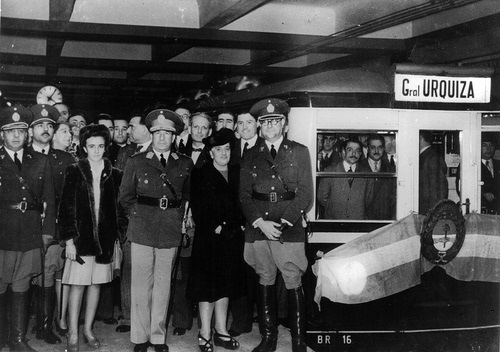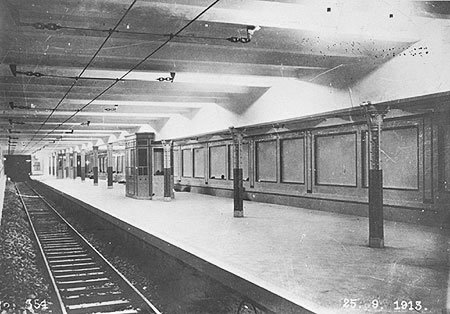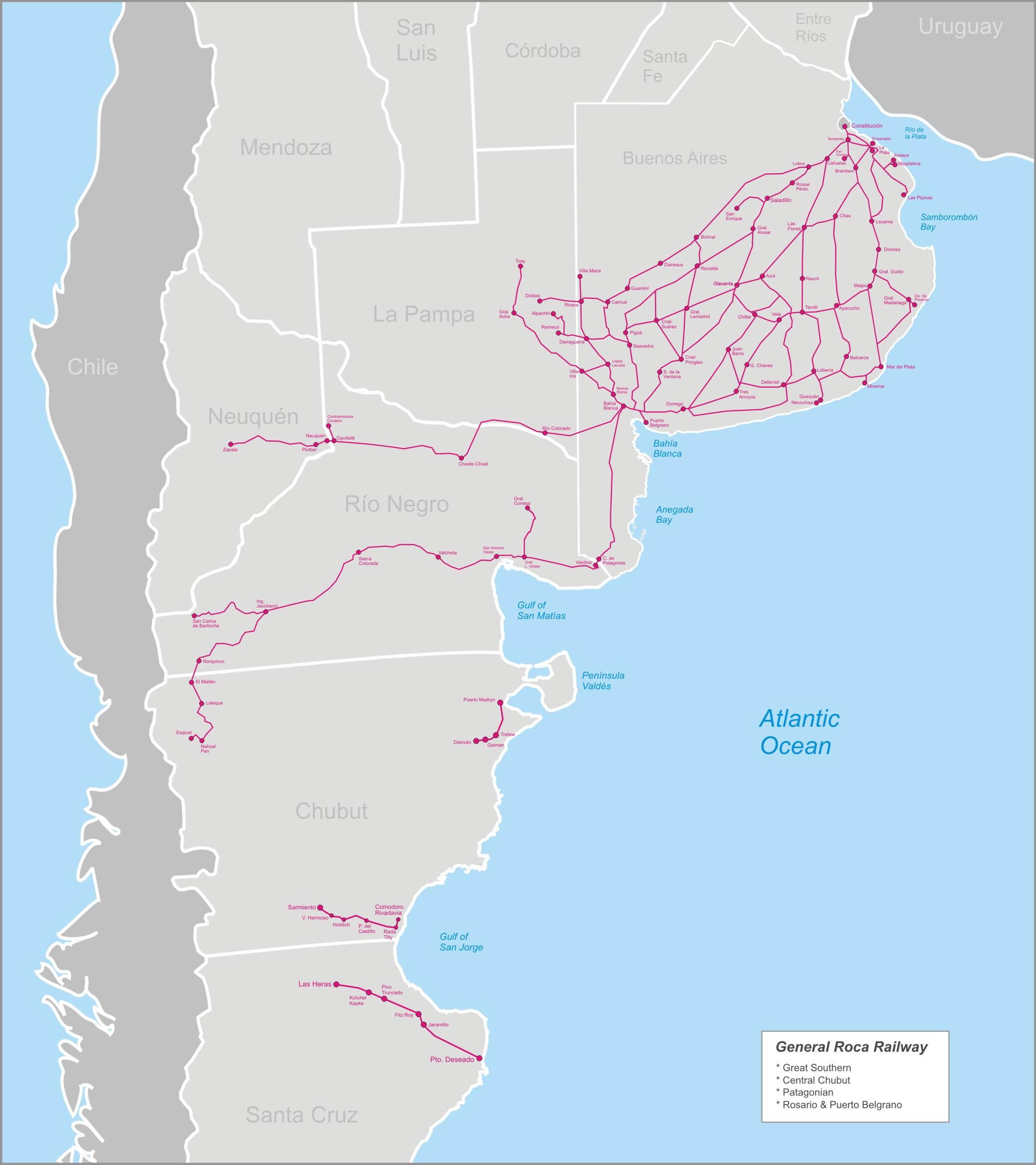|
Constitución (Line E Buenos Aires Underground)
Constitución is a ghost station in the Buenos Aires Underground, which was part of Line E until its closure in 1966. It is one of two ghost stations on the line, the other being San José vieja. This was the original terminus of the line when it ended at Constitución railway station and combined with Line C there. History The station was the original terminus of Line E when it still had its original trajectory to Constitución railway station where it combined with the General Roca Railway The General Roca Railway (FCGR) (native name: Ferrocarril General Roca) is a broad gauge railway in Argentina which runs from Constitución station in Buenos Aires to the south of the country through the provinces of Buenos Aires, La Pampa, .... However, the line was re-routed further towards the centre of the city in 1966 in order to improve the line's traffic and the station was closed along with San José vieja station on 24 April 1966. [...More Info...] [...Related Items...] OR: [Wikipedia] [Google] [Baidu] |
Constitución Railway Station
Constitución railway station () is a large railway station in Constitución, a in central Buenos Aires, Argentina. The full official name of the station is (in English: Constitution Square Station) reflecting the fact that the station is located opposite Constitution Square, two kilometers to the south of the landmark. The ground floor of the station has fourteen tracks and the floor below has two tracks for the Buenos Aires Underground. In 2021, the station received the heritage designation of National Historic Monument. History On 7 March 1864, in a ceremony attended by the president Bartolomé Mitre, construction began at Mercado Constitución, on the site of the present day terminus, as the British-owned Buenos Aires Great Southern railway company began building its first broad gauge line of 114 km as far as Chascomús. The first section of the line to Jeppener, Buenos Aires, was opened on 14 August 1865; during that same month a small terminal station at Mercad ... [...More Info...] [...Related Items...] OR: [Wikipedia] [Google] [Baidu] |
San José Vieja (Buenos Aires Underground)
San José vieja is a ghost station in the Buenos Aires Underground, which was part of Line E until its closure in 1966. It is one of two ghost stations on the line, the other being Constitución. History The station was part of Line E's original trajectory to Constitución railway station Constitución railway station () is a large railway station in Constitución, a in central Buenos Aires, Argentina. The full official name of the station is (in English: Constitution Square Station) reflecting the fact that the station is loca ... where it combined with Line C and terminated. However, the line was re-routed further towards the centre of the city in 1966 in order to improve the line's traffic and the station was closed along with Constitución station. In the year the line was re-routed, the station was still used briefly as part of a low-frequency branch of the line. However, when it was finally closed in that same year, it was used as a storage area for the line's ... [...More Info...] [...Related Items...] OR: [Wikipedia] [Google] [Baidu] |
Railway Stations Opened In 1944
Rail transport (also known as train transport) is a means of transport that transfers passengers and goods on wheeled vehicles running on rails, which are incorporated in tracks. In contrast to road transport, where the vehicles run on a prepared flat surface, rail vehicles (rolling stock) are directionally guided by the tracks on which they run. Tracks usually consist of steel rails, installed on sleepers (ties) set in ballast, on which the rolling stock, usually fitted with metal wheels, moves. Other variations are also possible, such as "slab track", in which the rails are fastened to a concrete foundation resting on a prepared subsurface. Rolling stock in a rail transport system generally encounters lower frictional resistance than rubber-tyred road vehicles, so passenger and freight cars (carriages and wagons) can be coupled into longer trains. The operation is carried out by a railway company, providing transport between train stations or freight customer faciliti ... [...More Info...] [...Related Items...] OR: [Wikipedia] [Google] [Baidu] |
Alberti Norte (Buenos Aires Underground)
Alberti Norte is a ghost station in the Buenos Aires Underground, which was part of Line A until its closure in 1953. It is one of two ghost stations on the line, the other being Pasco Sur. History The station was originally opened in 1913, as one of the original Line A stations opened that year. The station was unusual for the network in the sense that it only had one platform, serving only trains heading towards Plaza de Mayo, with the opposite platform located some metres away at Alberti station. Given its proximity to Pasco's northern platform (located just 124 metres away), both Alberti Norte and Pasco Sur stations were closed in 1953 in order to improve the line's frequency, since the close proximity of stations in that part of the line meant that trains could never accelerate to full speed before having to stop again. Upon the closure of the station, passengers could still see the unaltered station for many years from the line's trains. In the mid-1980s, the platform ... [...More Info...] [...Related Items...] OR: [Wikipedia] [Google] [Baidu] |
Pasco Sur (Buenos Aires Underground)
Pasco Sur is a ghost station in the Buenos Aires Underground, which was part of Line A until its closure in 1953. It is one of two ghost stations on the line, the other being Alberti Norte. History The station was originally opened in 1913, as one of the original Line A stations opened that year. The station was unusual for the network in the sense that it only had one platform, serving only trains heading towards Primera Junta (the terminus at the time), with the opposite platform located some metres away at Pasco station. Given its proximity to Alberti's southern platform (located just 124 metres away), both Pasco Sur and Alberti Norte stations were closed in 1953 in order to improve the line's frequency, since the closeness of stations in that part of the line meant that trains could never accelerate to full speed before having to stop again. Some theories claim that this station was closed as a result of the destruction and burning down of the building located above the ... [...More Info...] [...Related Items...] OR: [Wikipedia] [Google] [Baidu] |
Constitución Línea E
Constitución is Spanish for "constitution" and may refer to: Geography Argentina *Constitución, Buenos Aires, a neighborhood in central Buenos Aires, where the Estación Constitución railway station is located *Constitución Department, Santa Fe, an administrative subdivision of Santa Fe Province *Constitución railway station, a railway station and subway station in Buenos Aires **Constitución (Line C Buenos Aires Underground) **Constitución (Line E Buenos Aires Underground) *Villa Constitución, a city in Santa Fe Province and head town of the Constitución Department Chile *Constitución, Chile Mexico *Ciudad Constitución Ciudad Constitución is a city in the Mexican state of Baja California Sur. It is the seat of Comondú Municipality. As of 2019, the city had a total population of 45,888 inhabitants. Ciudad Constitución is a small city which serves as a gateway ..., in Baja California Sur Peru * Ciudad Constitución, Peru Ships * Chilean battleship ''Constitució ... [...More Info...] [...Related Items...] OR: [Wikipedia] [Google] [Baidu] |
Line C (Buenos Aires Underground)
Line C of the Buenos Aires Underground, that runs from Retiro to Constitución terminus, opened on 9 November 1934, and it has a length of . It runs under Lima Sur, Bernardo de Irigoyen, Carlos Pellegrini, Esmeralda, la Plaza San Martín and Avenida Ramos Mejia streets. It not only connects to every other line on the system (with the exception of Line H, which it is planned will be connected at a later date), but its termini at Retiro and Constitución also connect it to some of the most important commuter rail networks in Buenos Aires, such as the Mitre and Roca lines and also long-distance passenger services. It is thus an important artery in Buenos Aires' transport system. At the same time, it is also the shortest line in both terms of length and number of stations. It was the third line of the network to provide rail services to the public, after Line A and Line B. Up until 2007 with the opening of line H, it was the only line in the system providing a north–south ... [...More Info...] [...Related Items...] OR: [Wikipedia] [Google] [Baidu] |
Line E (Buenos Aires Underground)
Line E of the Buenos Aires Underground runs from Retiro to Plaza de los Virreyes, a total distance of 12 km. Opened in 1944, the Line E was the last completely new line to be added to the Buenos Aires Underground, until 2007 when Line H was opened. The line has a history of being re-routed and extended due to having been historically the line with the lowest passenger numbers on the network. History Line E was opened on 20 June 1944, after construction began in 1938, with an original route that ran from Constitución railway station to General Urquiza. Soon after, it was decided to abandon the terminus at Constitución (which also served as the connection with Line C) and instead reroute the line towards the Plaza de Mayo. Work began in 1957, and in 1966 the San José, Independencia, Belgrano and Plaza de Mayo (now Bolívar) stations were opened to the public by president Arturo Umberto Illia. For many years, the two stations that had been closed as a result of th ... [...More Info...] [...Related Items...] OR: [Wikipedia] [Google] [Baidu] |
General Roca Railway
The General Roca Railway (FCGR) (native name: Ferrocarril General Roca) is a broad gauge railway in Argentina which runs from Constitución station in Buenos Aires to the south of the country through the provinces of Buenos Aires, La Pampa, Neuquén and Río Negro. It was also one of the six state-owned Argentine railway divisions formed after President Juan Perón's nationalisation of the railway network in 1948, being named after former president Julio Argentino Roca. The six companies were managed by Ferrocarriles Argentinos which was later broken up during the process of railway privatisation beginning in 1991 during Carlos Menem's presidency. The Roca Railway is currently operated by State owned companies Trenes Argentinos (that operates commuter rail services in Buenos Aires) and Ferrobaires (for long-distance services) while freight transport is run by private companies Ferrosur Roca and Ferroexpreso Pampeano. History Background The first company to bui ... [...More Info...] [...Related Items...] OR: [Wikipedia] [Google] [Baidu] |
Buenos Aires Underground
The Buenos Aires Underground ( es, Subterráneo de Buenos Aires, links=no), locally known as Subte (), is a rapid transit system that serves the area of the city of Buenos Aires, Argentina. The first section of this network (Plaza de Mayo–Plaza Miserere) opened in 1913, making it the 13th subway in the world and the first underground railway in Latin America, the Southern Hemisphere, and the Spanish-speaking world, with the Madrid Metro opening five years later, in 1919. As of 2022, Buenos Aires is the only Argentine city with a metro system. Currently, the underground network's six lines—A, B, C, D, E, and H—comprise of routes that serve 90 stations. The network is complemented by the Premetro line, and the Urquiza suburban line, with 17 more stations in total. Traffic on lines moves on the left because Argentina drove on the left at the time the system opened. Over a million passengers use the network, which also provides connections with the city's extensive comm ... [...More Info...] [...Related Items...] OR: [Wikipedia] [Google] [Baidu] |
Ghost Station
A ghost station is a disused train station through which revenue-service passenger trains (especially rapid transit trains) pass but at which they do not stop. The term is also sometimes used for any unused underground station or any unused station, whether or not trains pass through them. In Germany, a station that has been built in the course of constructing something else as a so-called " :de:Bauvorleistung" (roughly: construction pre-effort) is referred to as a "ghost station", despite the different purpose and origin of the terms. Some English-language publications also refer to "pre-built" stations or parts thereof that have yet to see service as "ghost stations". Etymology The term "ghost station" is a calque of the German word (plural ). The German term was coined to describe certain stations on Berlin's and metro networks that were closed during the period of Berlin's division during the Cold War because they were an integral part of a transit line mostly locat ... [...More Info...] [...Related Items...] OR: [Wikipedia] [Google] [Baidu] |





